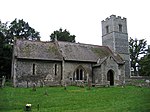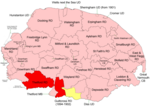St Helen's Church, Santon
Former churches in Norfolk
St Helen's Church was a church located near Santon, Norfolk, England. Its site is a scheduled monument. It was no longer in existence by 1368.The church is noted in the Domesday Book: "Among the lands of Stigand the archbishop which William de Noiers keeps for the use of the king, in Thetford ... one church of St. Helen, with one ploughland ..."
Excerpt from the Wikipedia article St Helen's Church, Santon (License: CC BY-SA 3.0, Authors).St Helen's Church, Santon
Santon Street, Breckland District Lynford
Geographical coordinates (GPS) Address Nearby Places Show on map
Geographical coordinates (GPS)
| Latitude | Longitude |
|---|---|
| N 52.4535 ° | E 0.7057 ° |
Address
Santon Street
Santon Street
IP27 0TX Breckland District, Lynford
England, United Kingdom
Open on Google Maps









